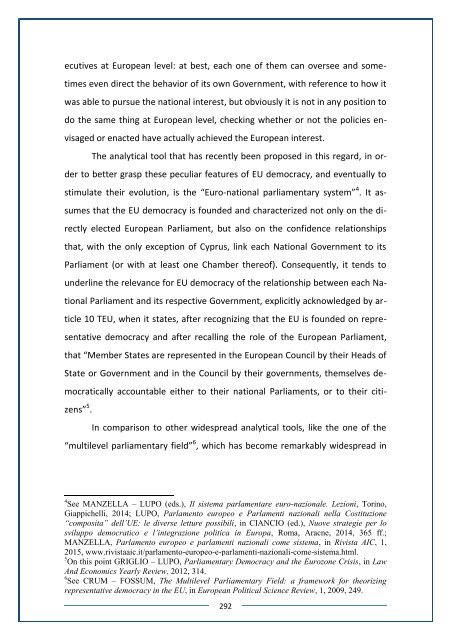ECONOMICS YEARLY REVIEW
Law_and_Economics_Yearly_Review_LEYR_Journal_vol_4_part_2_2015
Law_and_Economics_Yearly_Review_LEYR_Journal_vol_4_part_2_2015
You also want an ePaper? Increase the reach of your titles
YUMPU automatically turns print PDFs into web optimized ePapers that Google loves.
ecutives at European level: at best, each one of them can oversee and sometimes<br />
even direct the behavior of its own Government, with reference to how it<br />
was able to pursue the national interest, but obviously it is not in any position to<br />
do the same thing at European level, checking whether or not the policies envisaged<br />
or enacted have actually achieved the European interest.<br />
The analytical tool that has recently been proposed in this regard, in order<br />
to better grasp these peculiar features of EU democracy, and eventually to<br />
stimulate their evolution, is the “Euro-national parliamentary system” 4 . It assumes<br />
that the EU democracy is founded and characterized not only on the directly<br />
elected European Parliament, but also on the confidence relationships<br />
that, with the only exception of Cyprus, link each National Government to its<br />
Parliament (or with at least one Chamber thereof). Consequently, it tends to<br />
underline the relevance for EU democracy of the relationship between each National<br />
Parliament and its respective Government, explicitly acknowledged by article<br />
10 TEU, when it states, after recognizing that the EU is founded on representative<br />
democracy and after recalling the role of the European Parliament,<br />
that “Member States are represented in the European Council by their Heads of<br />
State or Government and in the Council by their governments, themselves democratically<br />
accountable either to their national Parliaments, or to their citizens”<br />
5 .<br />
In comparison to other widespread analytical tools, like the one of the<br />
“multilevel parliamentary field” 6 , which has become remarkably widespread in<br />
4 See MANZELLA – LUPO (eds.), Il sistema parlamentare euro-nazionale. Lezioni, Torino,<br />
Giappichelli, 2014; LUPO, Parlamento europeo e Parlamenti nazionali nella Costituzione<br />
“composita” dell’UE: le diverse letture possibili, in CIANCIO (ed.), Nuove strategie per lo<br />
sviluppo democratico e l’integrazione politica in Europa, Roma, Aracne, 2014, 365 ff.;<br />
MANZELLA, Parlamento europeo e parlamenti nazionali come sistema, in Rivista AIC, 1,<br />
2015, www.rivistaaic.it/parlamento-europeo-e-parlamenti-nazionali-come-sistema.html.<br />
5 On this point GRIGLIO – LUPO, Parliamentary Democracy and the Eurozone Crisis, in Law<br />
And Economics Yearly Review, 2012, 314.<br />
6 See CRUM – FOSSUM, The Multilevel Parliamentary Field: a framework for theorizing<br />
representative democracy in the EU, in European Political Science Review, 1, 2009, 249.<br />
292


